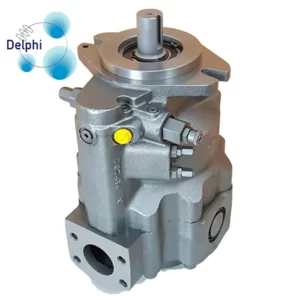The organization and categorization of a Parker hydraulic pump catalog are typically designed to assist customers in finding the right pump for their specific needs.
Here’s how such a catalog typically organizes and categorizes hydraulic pumps:
- Product Categories: The catalog will often start by dividing hydraulic pumps into broad product categories. These categories are based on the type and application of the pump. Common categories include gear pumps, vane pumps, piston pumps, and specialty pumps.
- Subcategories: Within each main product category, subcategories may be used to further refine the selection. For example, within the piston pump category, you might have subcategories like axial piston pumps and bent-axis piston pumps.
- Model Series: Each subcategory typically includes various model series of pumps. These model series often correspond to specific product lines or families of pumps with similar characteristics or applications. Each series may have its unique features.
- Performance Characteristics: For each pump series, the catalog usually provides detailed information on the performance characteristics of the pumps. This can include data such as flow rates, operating pressures, and displacements.
- Special Features and Technologies: The catalog highlights special features or technologies associated with each pump model. For instance, it might mention load-sensing capabilities, energy-efficient designs, noise reduction features, or compatibility with certain hydraulic fluids.
- Applications: Many catalogs include information about the typical applications where each pump series excels. This helps customers match the pump to their specific needs. Applications can range from mobile machinery (e.g., construction equipment) to industrial uses (e.g., manufacturing processes).
- Sizing and Selection Guidelines: The catalog may include guidelines or references for selecting the right pump size based on the application’s requirements. This could involve charts, tables, or formulas to help customers make informed choices.
- Accessories and Options: Information on compatible accessories, options, and components that can enhance or customize the pump’s functionality may be included in the catalog.
- Technical Data: Detailed technical data and specifications for each pump model are typically provided. This includes dimensions, weight, mounting options, and other technical details.
- Performance Curves: Some catalogs include performance curves that show the pump’s performance under different operating conditions. These curves help customers understand how the pump behaves in various scenarios.
- Cross-References: Cross-references to other parts, models, or manufacturers can be helpful for customers looking for alternatives or compatible components.
- Availability and Ordering Information: The catalog often includes information on availability, lead times, and how to place orders for the selected pump models. It may also provide contact details for sales and customer support.
By organizing and categorizing hydraulic pumps in this manner, the catalog aims to make it easier for customers to identify and select the most suitable pump for their specific applications and requirements. Customers can navigate the catalog to find the right pump category, series, and model that aligns with their needs.
What types of hydraulic pumps are included in the Parker catalog, and what are their primary applications?
The specific types of hydraulic pumps included in a Parker catalog may vary depending on the catalog’s edition and the company’s product offerings. However, Parker Hannifin, a well-known manufacturer of motion and control technologies, typically provides a wide range of hydraulic pumps, parker hydraulic pump catalog each designed for specific applications. Here are some common types of hydraulic pumps you might find in a Parker catalog, along with their primary applications:
- Gear Pumps:
- Primary Applications: Gear pumps are often used in applications that require moderate pressure and flow rates. They are suitable for various industrial and mobile equipment, including construction machinery and material handling equipment.
- Vane Pumps:
- Primary Applications: Vane pumps are commonly used in applications that demand smooth and consistent flow rates. These pumps find applications in industrial machinery, hydraulic presses, and machine tools.
- Piston Pumps:
- Primary Applications: Piston pumps are versatile and can handle high-pressure and high-flow applications. They are used in construction equipment, injection molding machines, and other heavy machinery.
- Axial Piston Pumps:
- Primary Applications: Axial piston pumps are known for their high efficiency and power density. They are used in demanding applications like forestry machinery, marine systems, and industrial presses.
- Bent-Axis Piston Pumps:
- Primary Applications: Bent-axis piston pumps are often used in applications where compact design and space-saving are crucial. They can be found in agricultural machinery, mining equipment, and aerospace systems.
- Radial Piston Pumps:
- Primary Applications: Radial piston pumps are designed for high-pressure applications. They are utilized in hydraulic presses, metal-forming machinery, and other high-force applications.
- Screw Pumps:
- Primary Applications: Screw pumps are ideal for handling high-viscosity fluids and are commonly used in industries such as oil and gas, petrochemical, and marine systems.
- External Gear Pumps:
- Primary Applications: External gear pumps are used in various applications, including power units, industrial machinery, and automotive systems.
- Peristaltic Pumps:
- Primary Applications: Peristaltic pumps are used in applications that require gentle and contamination-free pumping, such as pharmaceutical manufacturing and food processing.
- Diaphragm Pumps:
- Primary Applications: Diaphragm pumps are suitable for applications where leakage must be prevented, making them ideal for chemical processing, wastewater treatment, and medical devices.
Please note that Parker’s catalog may also include specialized and custom hydraulic pumps designed for specific industries and unique requirements. The primary applications mentioned here serve as general guidelines, and it’s essential to refer to the specific product details and recommendations within the catalog for accurate information regarding the appropriate use of each pump type.
